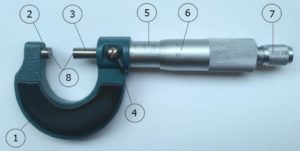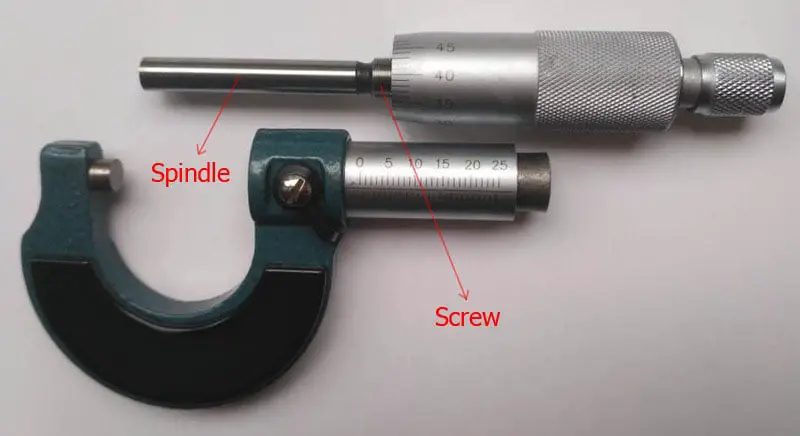It’s important to learn the micrometer body parts. It gives you a clear idea of how to use a micrometer, how to take the reading, and how it works. On this page, you’ll learn several micrometer body parts that you’ll find on a mechanical (vernier) micrometer.
10 Micrometer Parts (Mechanical Model)
A typical mechanical micrometer consists of the following body parts:
1. Frame
The frame is the U-shaped part of a micrometer. It also represents the range of measurement. The larger the frame, the longer the range. Whereas, the smaller the frame, the shorter the range. It also provides support to the anvil and the spindle to secure the object. In addition, it’s commonly coated with plastic material to prevent the user’s body heat moves to the micrometer.
2. Anvil
Anvil is the stationary part of a micrometer that functions to hold the object you are going to measure its dimension. It connects to the frame. There are various types of micrometers classified based on the anvil. There’s a particular micrometer in which the anvil is changeable. It means that you can replace it with another anvil type.
3. Spindle
Spindle functions like the anvil; holding the object, however, it’s the moveable one. By turning around the thimble, the anvil will rotate as well and axially moves forward or backward to both tighten and untighten the object as the users need. A spindle is actually a long tube metal in which half of its body is threaded. Therefore, it also directly connects to the screw.

4. Lock
You need to use this part to prevent the spindle from moving while taking the reading because any movement can cause inaccuracy. By turning it, you hold the object tightened. On the image above, it’s a nut lock type. You may notice another lock with a different look like a ring which you need to rotate to use it, but it functions the same.
5. Sleeve
The sleeve is a barrel where the primary scale of the micrometer takes place and the thimble rotates around it. It could be in millimeter or inch scale depends on the type you have. It’s stationary and in some cases, the vernier scale is etched on there. You’ll find an index line is located on there as well.
6. Thimble
The thimble is a barrel that looks like the sleeve as well, however, it acts as the movable one. It is bigger than the sleeve in terms of its diameter and therefore, rotates around the outer side of the sleeve. Also, it’s the area of the secondary scale takes place. It functions to magnify the resolution of the main scale, one division on the primary scale divided into more divisions again.
7. Ratchet
Ratchet is a rotatable cylindrical part that you can see at the very end of the micrometer opposite. It functions in such a way so that the object is held with appropriate pressure. Your micrometer can be broken if the pressure is too tight, whereas the reading is not accurate if the pressure is too weak. It releases a click sound if the pressure you give reaches the appropriate force.
8. Measuring Faces
Measuring faces are the surface that touches the objects you are going to measure. They take place on the edge of the anvil and spindle. If the micrometer is set to be zero, they will meet and touches together. These measuring faces should be made of strong material. In the past, the manufacturers used hardened steel to empower the measuring faces. Today, the vast majority of the company have been using carbide material to tip the measuring faces. And carbide has been recognized as the better material to be.
9. Screw
The screw determines how a micrometer works. It is the critical part of a micrometer. The screw takes position inside of the thimble barrel so you need to unassemble the micrometer to uncover the screw’s real shape. So this screw is actually a threaded spindle because it connects each other.

10. Scales
We take the reading on the scales. A micrometer has two main scales: the main scale which is located on the sleeve barrel and the second scale which is located on the thimble barrel. They can be in the metric (mm) or the imperial system (inch). Therefore, because they are not both using electronic displays, a mechanical micrometer has only one type of unit measurement, metric or imperial. There are some micrometers with an additional vernier scale on the upper side of the sleeve scale to provide greater resolution.
Digital Micrometer Parts
The major difference between the mechanical and digital micrometer parts is the display. This display is in the shape of a small LCD screen; substituting the thimble and sleeve scale function. In other words, the digital micrometer employs an LCD as the readout display.
Additionally, near the LCD screen, there are some buttons to send several commands such as zero reading, unit reading conversion, holding the reading, and even transferring the readout. So, it’s more advanced.
While the mechanical micrometer relies on the etched scales, you need to calculate those two scales to get the reading. So, it’s not instant. Further reading on the differences between mechanical and digital micrometers are consumable here.
There are some notes to keep in mind. Some digital micrometers also come with those two scales. This is good as you run out of battery, it’s still functional at any time.
Last Words
Those are the parts of a mechanical vernier micrometer. We hope you like it. If you may be in a search of a new micrometer for your project, you may find our micrometer reviews helpful to start the search. Thank you.
